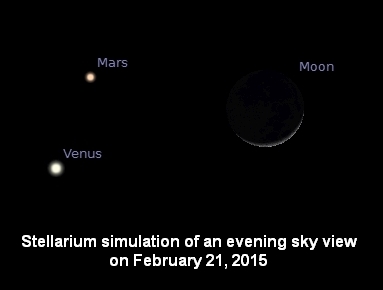¡SkyCaramba! Weekly astronomy blog for the week ending February 7, 2015
 The first night of February is a good one to try to see Neptune again. The eighth planet won’t be as close to Venus as it was to Mercury in January. But if you look at Venus in a telescope, you may spot the distant blue gas ball as close as 0.8° to the north. On the other side of the sky, however, the nearly full moon is rising. Enough of its life might pass Neptune appears to be moving toward the sun and will be in conjunction on the 26th.
The first night of February is a good one to try to see Neptune again. The eighth planet won’t be as close to Venus as it was to Mercury in January. But if you look at Venus in a telescope, you may spot the distant blue gas ball as close as 0.8° to the north. On the other side of the sky, however, the nearly full moon is rising. Enough of its life might pass Neptune appears to be moving toward the sun and will be in conjunction on the 26th.
The moon will be full on the 3rd. It passes Jupiter on the 4th as the big planet crosses the boundary from Leo to Cancer. Then on the 6th, Jupiter is up all night at opposition. Jupiter will continue moving toward Cancer all month.
While Venus settles into its reign in the evening sky, Mercury is reemerging in the morning. It won’t be close to any bright stars or planets to make it easier to identify. However, the messenger planet will be 26.7° west of the sun on the morning of the 24th. This greatest elongation will be especially good for viewers from the northern tropics to the southern middle latitudes.
Saturn is rising earlier each morning and is high in the east by sunrise at the end of the month. After passing within 1° of Acrab in Scorpio in late January, the ringed planet continues moving eastward past the star in all of February. A last quarter moon passes by both on the 12th.
Back to our evening sky, Venus is moving closer to Mars this month. They’re fairly close together when a three-day old moon passes by them on the 21st. Uranus is in the neighborhood too and the moon will pass in  front of it about 24 hours later. That occultation will be visible from southern Quebec to the Bahamas and as far east as Bermuda.
front of it about 24 hours later. That occultation will be visible from southern Quebec to the Bahamas and as far east as Bermuda.
If you live in Greenland, Iceland, and the old Scandinavian countries, you will see the moon occult Aldebaran on the 25th. This is the second of 49 moon-Aldebaran occultations that will occur every 29 days or so until September 2018.
This month, we should expect to hear more about the NASA Dawn spacecraft’s approach to Ceres. Dawn is expected to enter orbit around the asteroid about March 6. The exact date and orbital details aren’t certain yet. Scientists don’t know as much as they’d like about the asteroid’s mass, and that kind of knowledge is required to calculate how a spacecraft or anything else will act in its gravity.
¡SkyCaramba!